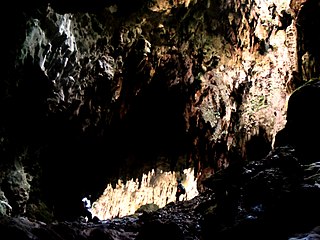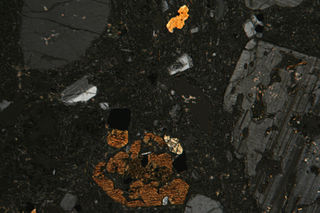
Chert is a hard, fine-grained sedimentary rock composed of crystals of quartz (silica) that are very small (microcrystalline or cryptocrystalline). Quartz (silica) is the mineral form of silicon dioxide (SiO2). Chert is often of biological origin (organic) but may also occur inorganically as a chemical precipitate or a diagenetic replacement (e.g., petrified wood). Geologists use chert as a generic name for any type of microcrystalline or cryptocrystalline quartz.
In archaeology, lithic analysis is the analysis of stone tools and other chipped stone artifacts using basic scientific techniques. At its most basic level, lithic analyses involve an analysis of the artifact’s morphology, the measurement of various physical attributes, and examining other visible features.
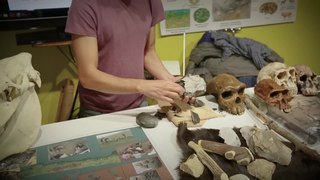
In the archaeology of the Stone Age, an industry or technocomplex is a typological classification of stone tools. It is not to be confused with industrial archaeology, which concentrates on industrial sites from more recent periods.

In archaeology, a blade is a type of stone tool created by striking a long narrow flake from a stone core. This process of reducing the stone and producing the blades is called lithic reduction. Archaeologists use this process of flintknapping to analyze blades and observe their technological uses for historical peoples.
The term Hòa Bình culture was first used by French archaeologists working in Northern Vietnam to describe Holocene period archaeological assemblages excavated from rock shelters. The related English adjective Hoabinhian has become a common term in the English-based literature to describe stone artifact assemblages in Southeast Asia that contain flaked, cobble artifacts, dated to c. 10,000–2000 BCE. The term was originally used to refer to a specific ethnic group, restricted to a limited period with a distinctive subsistence economy and technology. More recent work uses the term to refer to artifacts and assemblages with certain formal characteristics.

Fuga Island is an island north of Luzon, part of the Babuyan Archipelago, which is the second-northernmost island group of the Philippines. It has an area of 100 square kilometres (39 sq mi) and a population of 2,015 persons. The principal settlement is Naguilian (Musa) village on the southern coast. The highest peak is Mount Nanguringan in the northeast, with an elevation of 191 metres (627 ft).
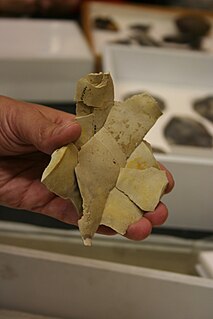
Debitage is all the material produced during the process of lithic reduction and the production of chipped stone tools. This assemblage includes, but is not limited to, different kinds of lithic flakes and lithic blades, shatter and production debris, and production rejects.
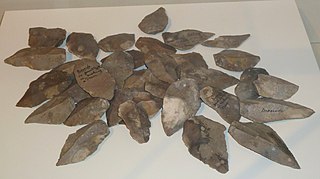
A Bann flake is a large, butt-trimmed, leaf-shaped lithic blade of flint or chert, dating from the Late Mesolithic period of prehistoric Ireland, from around 4500 BC onwards. They are named after the river Bann in Northern Ireland where large numbers have been found. The term is rather variably defined, and the uses of the flakes probably varied considerably, with many being all-purpose tools, and perhaps weapons. Some were probably used as spear heads attached to wooden shafts, despite many being rather heavy for this.
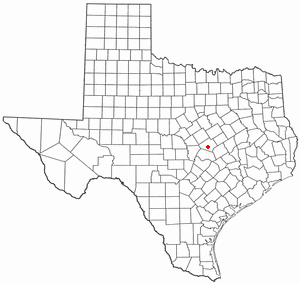
Buttermilk Creek Complex refers to the remains of a paleolithic settlement along the shores of Buttermilk Creek in present-day Salado, Texas dated to approximately 15,500 years old. If confirmed, the site represents evidence of human settlement in the Americas that pre-dates the Clovis culture.

Hazar Merd is a group of Paleolithic cave sites excavated by Dorothy Garrod in 1928. The caves are located south-southwest of Sulaymaniyah in Sulaymaniyah Governorate in Iraq. Garrod's soundings in two caves in the Hazar Merd group provided evidence of Middle and Epi-Paleolithic occupation.The Dark cave or Ashkawty Tarik in Kurdish has a commanding view of the local valley and is close to a small spring and a village with the same name.

Franktown Cave is located 25 miles south of Denver, Colorado on the north edge of the Palmer Divide. It is the largest rock shelter documented on the Palmer Divide, which contains artifacts from many prehistoric cultures. Prehistoric hunter-gatherers occupied Franktown Cave intermittently for 8000 years beginning about 6400 B.C. The site held remarkable lithic and ceramic artifacts, but it is better known for its perishable artifacts, including animal hides, wood, fiber and corn. Material goods were produced for their comfort, task-simplification and religious celebration. There is evidence of the site being a campsite or dwelling as recent as AD 1725.

New Guinea II is a limestone cave and rockshelter on the Snowy River at the end of New Guinea Track, near Buchan, Victoria. The cave was within the country of the Krowathunkooloong clan of the Gunaikurnai nation. The deep cave system has an overhanging cliff that creates a rock shelter at the entrance facing the river. Excavations in the 1980s carried out by archaeologist Paul Ossa and a team from LaTrobe University found stone artefacts, and other signs of occupation that were dated to almost 20,000 BP.
Dewil Valley, located in the northernmost part of Palawan, an island province of the Philippines that is located in the MIMAROPA region, is an archaeological site composed of thousands of artifacts and features. According to the University of the Philippines Archaeological Studies Program, or UP-ASP, the closest settlement can be found in New Ibajay, which is covered by the town capital of El Nido, which is located around 9 km (5.6 mi) south-east of Dewil Valley. Physically it measures around 7 km (4.3 mi) long, and 4 km (2.5 mi) wide. It is in this place which the Ille Cave, one of the main archaeological sites, can be found. It is actually a network of 3 cave mouths located at its base. It has been discovered that this site in particular has been used and occupied by humans over multiple time periods.
Misamis Oriental can be found in Northern Mindanao, Philippines. It is divided into twenty-three municipalities and two main cities. Its capital, Cagayan de Oro, is an urbanized location and independently governs itself from Misamis Oriental.

Lapuz Lapuz Cave is among the many cave sites found in the Bulabog Putian National Park in Moroboro, Dingle, Iloilo in the Philippines. It is 90 m (295.3 ft) long and light reaches up to within 30 m (98.4 ft) from each of its two entrances. The limestone area at its south end is adjacent to Jalaur River, while the north side is adjacent to the Tambunac River.

Kilu Cave is a paleoanthropological site located on Buka Island in the Autonomous Region of Bougainville, Papua New Guinea. Kilu Cave is located at the base of a limestone cliff, 65 m (213 ft) from the modern coastline. With evidence for human occupation dating back to 29,000 years, Kilu Cave is the earliest known site for human occupation in the Solomon Islands archipelago.
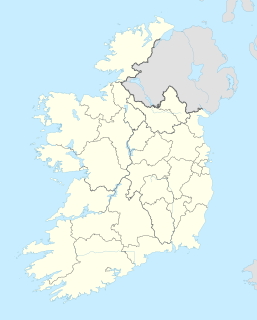
Belderrig is a small village on the North Mayo coast, and lies within the Céide Fields complex, a prehistoric landscape of field systems and related domestic and ritual structures dating to the Neolithic and Bronze Age. The excavations at Belderrig were initiated by Graeme Warren, School of Archaeology, University College Dublin, Ireland, after visiting the site in 2003 with its discoverer, the archaeologist Seamas Caulfield.

Nwya Devu is a high-altitude archaeological site on the Tibetan Plateau located in the eastern Changtang region of Tibet. At around 4,600 m (15,092 ft) above sea level, Nwya Devu is the highest known archaeological site from the Paleolithic and provides evidence for the earliest known presence of humans at a high-altitude site, at around 40,000-30,000 BP.
